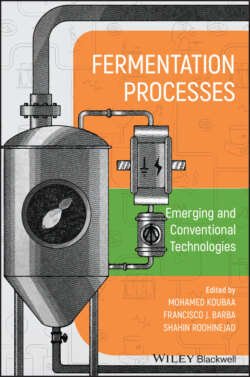Читать книгу Fermentation Processes: Emerging and Conventional Technologies - Группа авторов - Страница 23
1.2.4 Fermentation
ОглавлениеSome microbial species can obtain their energy in the absence of O2 through the catabolic pathway of fermentation. The only difference compared to respiration is in the final electron acceptor (Angelidaki et al. 2011; Dunford 2012; Madigan et al. 2015). In this case, ATP is produced without the Krebs cycle or an electron transport chain involved. This metabolic pathway does not require O2, because ATP comes exclusively from glycolysis, and the last electron acceptor is an organic molecule such as pyruvic acid (or a derived molecule). Figure 1.4 summarizes the metabolic pathway of fermentation.
As shown in Figure 1.4, glucose is oxidized during glycolysis to form two molecules of pyruvate. The electrons and protons released during this pathway are captured by the NAD+ to be reduced to NADH + H+. As shown above, two molecules of ATP are produced during glycolysis. To regenerate the NAD+, the NADH + H+ must be reoxidized; otherwise, the oxidation of glucose will stop and glycolysis too. During this oxidation, electrons and protons are directly transferred to pyruvate or one of its derivatives. The reduction of these final electron acceptors results in the formation of many different compounds, which provide a great variety of types of fermentation. At the same time, the NAD+ is regenerated and can engage in another round of glycolysis. The goal is to provide an uninterrupted supply of NAD+, which allows uninterrupted oxidation of glucose.
During fermentation, all ATP is produced solely by glycolysis, which implies a much lower energy yield compared to aerobic respiration (2 mol of ATP against 38 in prokaryotes). Considering that glucose oxidation is partial, a large part of the energy originally contained in glucose remains stored in the chemical bonds of the final fermentation product (e.g. ethanol, lactic acid, etc.). Fermentation microorganisms must, therefore, compensate for this shortfall by the oxidation of a larger quantity of substrate.
Figure 1.4 Schematic representation of fermentation and energy generation.
Different microorganisms can metabolize organic substrates (e.g. monosaccharides, amino acids, glycerol, etc.) (Angelidaki et al. 2011) to produce organic products such as acids, alcohols, and gases (Wilkins and Atiyeh 2012). This transformation occurs when all essential conditions and factors (e.g. temperature, pH, sugar concentration, culture medium, dissolved O2, and other micronutrients) required to the growth of microorganisms are provided (Smith 2009). Besides, the microorganism used must be viable, genetically stable, and able to resist several factors including the high concentrations of substrate, salt, and product, and sometimes to the presence of inhibitors, especially when using an industrial by‐product, or a lignocellulosic hydrolyzate.
Under anaerobic conditions, pyruvate is fermented to a wide range of fermentation products; most of them are of industrial importance (Figure 1.5). In general, microorganisms can be grouped into two classes according to the number of compounds that will be produced during fermentation: homofermentaries and heterofermentaries. Homofermentative microorganisms use a fermentation pathway that leads to the production of a single compound. For example, some lactic acid bacteria can oxidize glucose to produce only lactic acid. Heterofermentative microorganisms, on the other hand, use a fermentation pathway that generates several compounds after the oxidation of the substrate. For example, the bacterium E. coli can produce several types of organic acids during the fermentation of glucose. The following are among the most occurring industrial fermentative products: ethanol, lactic acid, propionic acid, butyric acid, and acetone (Eş et al. 2017; Lin et al. 2014; Navarrete‐Bolaños et al. 2013; Ruijschop et al. 2008).
